Table of Contents [expand]
Last updated June 13, 2023
The modern day developer has a wide variety of techniques and technologies available to improve application performance and end-user experience. One of the most frequently overlooked technologies is that of the HTTP cache.
HTTP caching is a universally adopted specification across all modern web browsers, making its implementation in web applications simple. Appropriate use of these standards can benefit your application greatly, improving response times and reducing server load. However, incorrect caching can cause users to see out-of-date content and hard to debug issues. This article discusses the specifics of HTTP caching and in what scenarios to employ an HTTP cache header based strategy.
Overview
HTTP caching occurs when the browser stores local copies of web resources for faster retrieval the next time the resource is required. As your application serves resources it can attach cache headers to the response specifying the desired cache behavior.
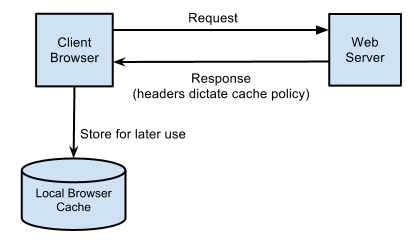
When an item is fully cached, the browser may choose to not contact the server at all and simply use its own cached copy:
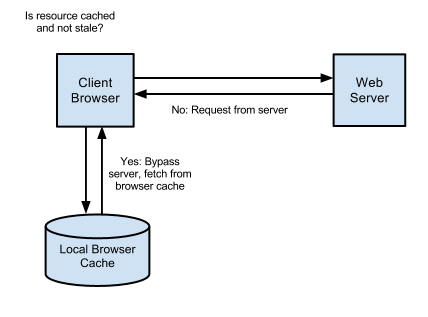
For instance, once CSS stylesheets from your application are downloaded by the browser there’s no need to download them again during the user’s session. This holds true for many asset types like javascript files, images and even infrequently changing dynamic content. In these instances it is beneficial for the users browser to cache this file locally, and use that copy whenever the resource is requested again. An application using HTTP cache headers is able to control this caching behavior and alleviate server-side load.
It is intuitive to think about the end-user’s browser as the primary consumer of HTTP cache headers. However, these HTTP cache headers are available to be, and are acted upon by, every intermediate proxy and cache between the source server and the end user.
HTTP cache headers
There are two primary cache headers, Cache-Control and Expires.
Cache-Control
Without the cache-control header set, no other caching headers will yield any results.
The Cache-Control header is the most important header to set as it effectively ‘switches on’ caching in the browser. With this header in place, and set with a value that enables caching, the browser will cache the file for as long as specified. Without this header the browser will re-request the file on each subsequent request.
public resources can be cached not only by the end-user’s browser but also by any intermediate proxies that may be serving many other users as well.
Cache-Control:public
private resources are bypassed by intermediate proxies and can only be cached by the end-client.
Cache-Control:private
The value of the Cache-Control header is a composite one, indicating whether the resource is public or private while also indicating the maximum amount of time it can be cached before considered stale. The max-age value sets a timespan for how long to cache the resource (in seconds).
Cache-Control:public, max-age=31536000
While the Cache-Control header turns on client-side caching and sets the max-age of a resource the Expires header is used to specify a specific point in time the resource is no longer valid.
Expires
When accompanying the Cache-Control header, Expires simply sets a date from which the cached resource should no longer be considered valid. From this date forward the browser will request a fresh copy of the resource. Until then, the browsers local cached copy will be used:
If both Expires and max-age are set max-age will take precedence.
Cache-Control:public
Expires: Mon, 25 Jun 2012 21:31:12 GMT
While Cache-Control and Expires tells the browser when to next retrieve the resource from the network a few additional headers specify how to retrieve the resource from the network. These types of requests are known as conditional requests.
Conditional requests
Conditional requests are those where the browser can ask the server if it has an updated copy of the resource. The browser will send some information about the cached resource it holds and the server will determine whether updated content should be returned or the browser’s copy is the most recent. In the case of the latter an HTTP status of 304 (not modified) is returned.
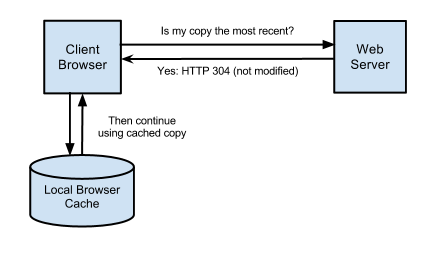
Though conditional requests do invoke a call across the network, unmodified resources result in an empty response body – saving the cost of transferring the resource back to the end client. The backend service is also often able to very quickly determine a resource’s last modified date without accessing the resource which itself saves non-trivial processing time.
Time-based
A time-based conditional request ensures that only if the requested resource has changed since the browser’s copy was cached will the contents be transferred. If the cached copy is the most up-to-date then the server returns the 304 response code.
To enable conditional requests the application specifies the last modified time of a resource via the Last-Modified response header.
Cache-Control:public, max-age=31536000
Last-Modified: Mon, 03 Jan 2011 17:45:57 GMT
The next time the browser requests this resource it will only ask for the contents of the resource if they’re unchanged since this date using the If-Modified-Since request header
If-Modified-Since: Mon, 03 Jan 2011 17:45:57 GMT
If the resource hasn’t changed since Mon, 03 Jan 2011 17:45:57 GMT the server will return with an empty body with the 304 response code.
Content-based
The ETag (or Entity Tag) works in a similar way to the Last-Modified header except its value is a digest of the resources contents (for instance, an MD5 hash). This allows the server to identify if the cached contents of the resource are different to the most recent version.
This tag is useful when for when the last modified date is difficult to determine.
Cache-Control:public, max-age=31536000
ETag: "15f0fff99ed5aae4edffdd6496d7131f"
On subsequent browser requests the If-None-Match request header is sent with the ETag value of the last requested version of the resource.
If-None-Match: "15f0fff99ed5aae4edffdd6496d7131f"
As with the If-Modified-Since header, if the current version has the same ETag value, indicating its value is the same as the browser’s cached copy, then an HTTP status of 304 is returned.
Visibility
Most modern browsers include robust request/response visualization and introspection tools. The Web Inspector found in both Chrome and Safari shows the response and request headers in the Network tab.
Code for a sample application that uses the various cache headers can be found on GitHub.
Here’s an example initial request that shows the default set of headers returned by the application (with no cache directives).
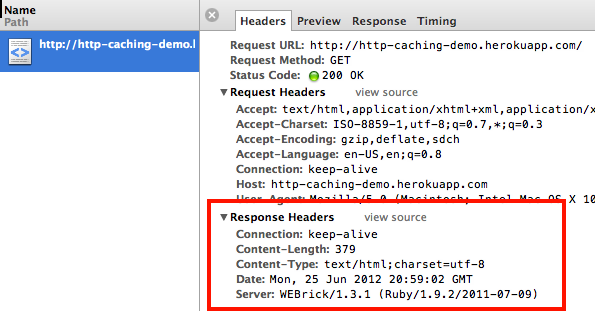
By adding the cache query parameter, the application turns on caching with both Cache-Control and Expires headers (both of which are set to 30 seconds in the future).
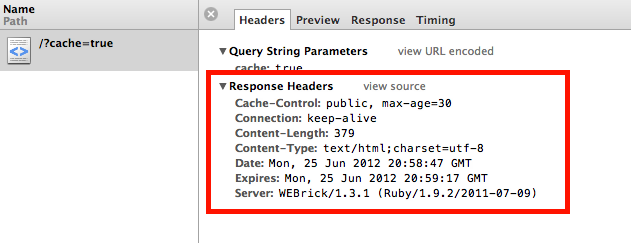
Adding an etag parameter to the request causes the sample app to specify the ETag digest of the JSON contents.
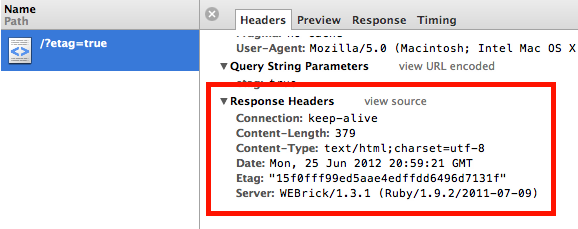
On deeper inspection, the ETag-based conditional request executes as expected. With the initial request, the browser downloads the file from the server:

On subsequent requests, you see the server respond to the browsers ETag check with a HTTP status of 304 (not modified) which causes the browser to use its own cached copy:

Use Cases
Static assets
Under normal usage, the starting point for any developer should be to add as an aggressive caching strategy to the files in the application that will not change. Normally this will include static files that are served by the application such as images, CSS file and Javascript files. As these files are typically re-requested on each page, a large performance improvement can be had with little effort.
In these instances, you should set the Cache-Control header, with a max-age value of a year in the future from the time of the request. It is recommended that Expires should be set to a similar value.
1 year is 31536000 seconds
Cache-Control:public; max-age=31536000
Expires: Mon, 25 Jun 2013 21:31:12 GMT
It is not generally a good idea to go any further than this as greater time periods are not supported by the RFC and may be ignored.
Dynamic content
Dynamic content is much more nuanced. For each and every resource, the developer must assess how heavily it can be cached and what the implications might be of serving stale content to the user. Two examples would be the contents of a blog RSS feed (which will not change more than once every few hours), to the JSON packets which drive a user’s Twitter timeline (updating once every few seconds). In these cases it would be reasonable to cache the resources for as long as you believe possible without causing issues for the end user.
Private content
Private content (ie. that which can be considered sensitive and subject to security measures) requires even more assessment. Not only do you as the developer need to determine the cacheability of a particular resource, but you also need to consider the impact of having intermediary caches (such as web proxies) caching the files which may be outside of the users control. If in doubt, it is a safe option to not cache these items at all.
Should end-client caching still be desirable you can ask for resources to only be cached privately (i.e only within the end-user’s browser cache):
Cache-Control:private, max-age=31536000
Cache prevention
Highly secure or variable resources often require no caching. For instance, anything involving a shopping cart checkout process. Unfortunately, merely omitting cache headers will not work as many modern web browsers cache items based on their own internal algorithms. In such cases it is necessary to tell the browser to explicitly to not cache items.
In addition to public and private the Cache-Control header can specify no-cache and no-store which informs the browser to not cache the resources under any circumstances.
Both values are required as IE uses no-cache, and Firefox uses no-store.
Cache-Control:no-cache, no-store
Implementation
Once the concepts behind HTTP caching are understood the next step is to implement them in your application. Most modern web frameworks make this a trivial task.
| Language/framework | Tutorials |
|---|---|
| Ruby/Rails |
|